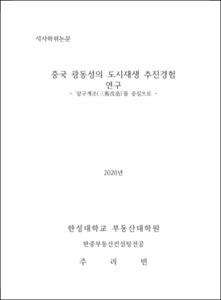중국 광동성의 도시재생 추진경험 연구
= Study on the Experience of Urban Regeneration in Guangdong Province, China: Focused on the Three Old(Old Town, Old Factory and Old Village) Regeneration
- Type
- Thesis
- Alternative Title
- - '삼구개조(三舊改造)'를 중심으로 -
- Department
- 부동산대학원 한중부동산컨설팅전공
- Issued Date
- 2020
- Publisher
- 한성대학교 부동산대학원
- Files in This Item:
-
-
Download
 200000335711.pdf
기타 데이터 / 1.5 MB / Adobe PDF
200000335711.pdf
기타 데이터 / 1.5 MB / Adobe PDF
-
Items in Repository are protected by copyright, with all rights reserved, unless otherwise indicated.